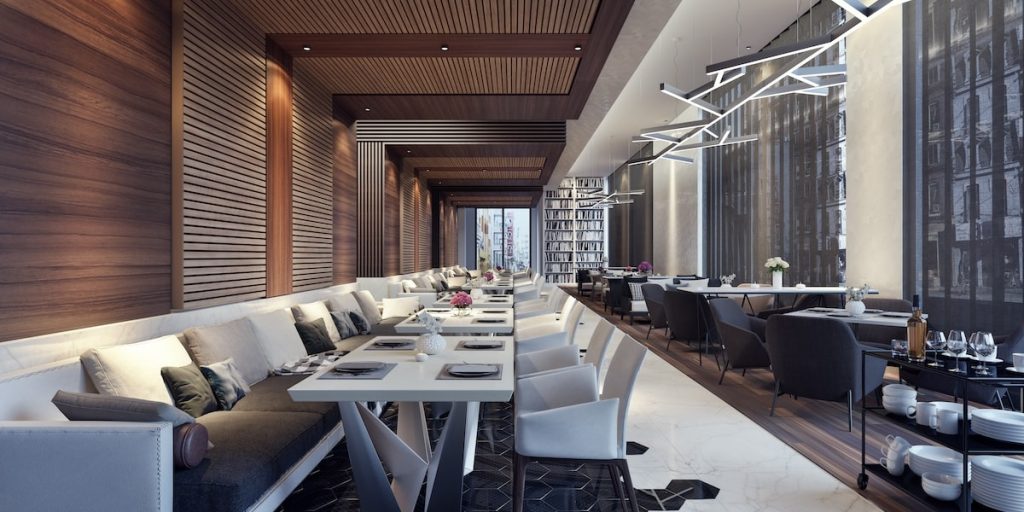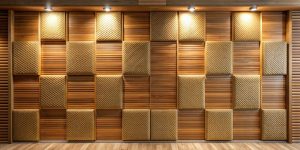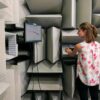The Science of Reverberation: Managing Echo for Clearer Conversations
Do you ever find it difficult to hear someone in a loud cafeteria or conference room? Does your voice get hoarse and tired after a day of meetings in a reverb-heavy boardroom? Nobody wants to shout to be heard. In spaces designed for conversation or group work, reverberation can be a real buzzkill.
Luckily, with the right acoustic treatment, you can dramatically improve speech in any room. In this blog, we’ll dive into the nitty gritty of reverb: what causes it, where it occurs, and how to manage it for comfortable sound.
What Is Reverberation and How Does It Affect Sound?
Reverberation is the continuation of sound in an enclosed space after the sound is produced. It’s the result of sound energy bouncing off walls, ceilings, floors, and objects.
To get scientific, it’s quantified by RT60 (reverberation time 60dB), which is the amount of time it takes for a sound to decrease by 60 decibels. The higher the RT60, the longer the room reverb and more muddied or chaotic the audio environment.
But make note, reverberation is not echo. An echo is an audible repetition of sound from a distant surface while reverberation is a group of closely spaced reflections that sound more like a “tail” than a repeat. Echo tends to be very disruptive while reverb tends to mask other audio information like speech. Think about how much you can hear when you talk in a tiled bathroom compared to a carpeted family room. The different materials either reflect or absorb the sound energy. The more reflective a room is due to hard flat surfaces, the worse the acoustic insulation is. This noise reflection is problematic in rooms with poor soundproofing. If a room has excessive noise reflection, it’s an acoustically active space which has poor audio intelligibility.
Spaces Most Affected by Poor Reverberation Management
The following spaces are the most likely to suffer from room reverb because of the way they are designed. In general, larger, boxier rooms with harder surfaces have the most trouble with intelligibility from noise reflection.
Rooms in which intelligibility is important, like classrooms, conference rooms, and dining rooms, need to manage reverb to maximize comfort and productivity. Where RT60 is higher than it needs to be, it can cause problems with clarity and create “reverb headaches.” Therefore it’s essential that good commercial space acoustics support productivity, reduce listener fatigue, and enhance the overall comfort and usability of shared environments.
Classrooms
Classroom acoustics can impact student comprehension and teacher well-being. Increased reverberation times result in poor speech intelligibility and decreased student engagement. Blurred consonants and garbled audio make it more difficult for students to keep up. Teachers may raise their voices to compensate, leading to fatigue and vocal strain. Proper acoustic treatment can have a positive effect on learning outcomes by enhancing student concentration and reducing distractions.
Boardrooms & Offices
Office noise control is more important than ever in a hybrid work environment. Open floor plans are common, but when they’re not treated with acoustical soundproofing or acoustical treatment, meetings can become exhausting noise challenges. Excessive reverberation can cause miscommunication, particularly over video conferences where the room noise gets picked up by microphones. Boardroom noise solutions like wall-mounted acoustic panels and ceiling treatments improve audio clarity for all participants, whether they’re in the room or joining remotely.
Dining Areas & Restaurants
Restaurant acoustics play a huge role in customer satisfaction. Eating spaces can quickly become stressful shouting matches if they’re reverb-heavy. Loud noise environments from high RT60 can make it difficult to enjoy conversations with friends and family, leading to increased stress levels and negative reviews. Restaurant sound control strategies, like ceiling acoustic panels and sound absorption panels, can significantly improve the customer experience.
Acoustic Solutions to Manage Reverberation
The first step in managing reverb is reducing sound reflection and lowering RT60 time. This is achieved with products that absorb or diffuse sound energy, also known as acoustic treatment. Combining both absorption and diffusion is ideal.
Acoustic Panels for Walls
Echo reduction starts with the installation of acoustic wall panels. Wall-mounted sound absorbers are an effective way to reduce mid-to-high frequency reflections, especially in rooms with limited floor space. Products like Fabric Wrapped Panels and Echo Eliminator Panels absorb mid-to-high-frequency sound energy that interferes with speech clarity.
Secondly, placement is key. Panels should be installed at primary reflection points (PRTs) which are typically the walls across from the speaker or conversational area. Balance the acoustic wall panel coverage across the space for the best results and to avoid creating “dead” or “live” zones in the room.
Ceiling Treatments
Ceiling-mounted acoustic panels are a great choice for large or open spaces that need to reduce overhead reverberation. StarField Ceiling Panels and Poly Max Panels can reduce reverb without interfering with the visual design of a room. Ceiling treatments are especially effective in restaurants and open-plan offices where other surfaces are either limited or need to remain furniture and fabric-free.
Bass Traps and Corner Absorbers
Low-frequency reverberation is difficult to treat and is often overlooked. For multipurpose rooms or AV setups, add bass traps like Bass Buster and corner absorbers like CornerSorber to catch low-end build up that can muddy music and speech.
Acoustic Art Panels for Aesthetic Spaces
In design-sensitive areas where standard wall panels won’t work, acoustic wall art can be a stylish option. The Acoustic Wall Art line combines the aesthetics of artwork with the performance of sound absorption, making them a great choice for dining rooms, hotel lobbies, and retail spaces. Not only do they enhance your space, but they look as good as they sound.
Measuring and Managing RT60 for Optimal Clarity
Improving room acoustics requires a tailored combination of material type, placement, and surface coverage to create a more controlled and intelligible sound environment. The first step in a successful reverb management strategy is knowing where your room is starting from.
To do this, you’ll need to know the current RT60.
RT60 Targets for Different Applications
| Room Type | RT60 Target |
|---|---|
| Classrooms | 0.4–0.6 seconds |
| Boardrooms | 0.5–0.7 seconds |
| Restaurants | 0.7–1.0 seconds |
| Music Rooms | 1.2–2.2 seconds (depending on genre and listening environment) |
RT60 can be tested using a professional audio analyzer or a smartphone app with a calibrated mic to get a ballpark estimate.
From there, acoustic modeling software can be used to create a visual of how treatment options will affect a space. For more complex spaces, we recommend an expert consultation to ensure that the correct materials and placement are used.
Real-World Example: How Acoustic Treatment Transformed a Meeting Room
A specific example we managed was the leadership team at a mid-size marketing firm was having difficulties with acoustics in their glass-walled boardroom.
Participants frequently complained that they couldn’t hear each other during in-person meetings, and remote attendees were regularly bothered by audio echo and dropouts during video conferences. An initial analysis found that the RT60 was 1.4 seconds, more than double the recommended reverberation time for boardrooms. The team decided to go with a full-room upgrade using a Full Room Treatment Pack which included wall mounted Fabric Wrapped Panels, ceiling Poly Max Panels, and CornerSorbers. RT60 measurements following installation came in at 0.6 seconds.
The results: Improved communication, fewer Zoom complaints, and an overall more energized and professional meeting environment.
Acoustic Geometry’s Full Room Treatment Packs offer bundled solutions tailored to different space types, making it easy to start your acoustic upgrade with everything you need.
Final Tips for Effective Reverberation Management
Managing reverberation is more than just installing a few acoustic panels. A successful approach requires a holistic strategy that considers aesthetics, functionality, and performance. Carpets and furniture are not enough.
For situations where privacy or external noise intrusion is a concern, like in executive offices or therapy rooms, dedicated soundproof room treatment may be necessary in addition to standard acoustic panels. While soft furnishings and carpets can provide some room treatment, their sound absorption properties are minimal. Avoid over damping the room by balancing absorption and diffusion. Sound diffusion works by scattering sound waves evenly across a room, which helps maintain a natural ambiance without creating harsh or ‘dead’ zones. A mix of soft and diffusive surfaces helps prevent over damping a room and maintains a natural sound.
Remember to treat all three dimensions of the room. For full-spectrum coverage, apply treatment to walls, ceilings, and corners of a room.
It’s important to choose the right products, too. Quality acoustic wall panels are designed to deliver both form and function like Fabric Wrapped Panels and Acoustic Wall Art. In short, you get what you pay for.
When done right, improving acoustics through better reverberation management can drastically increase the usability and comfort of commercial spaces. Check out the full collection of solutions at Acoustic Geometry or contact us for a free consultation to discover your space’s full potential.





















Add comment
You must be logged in to post a comment.